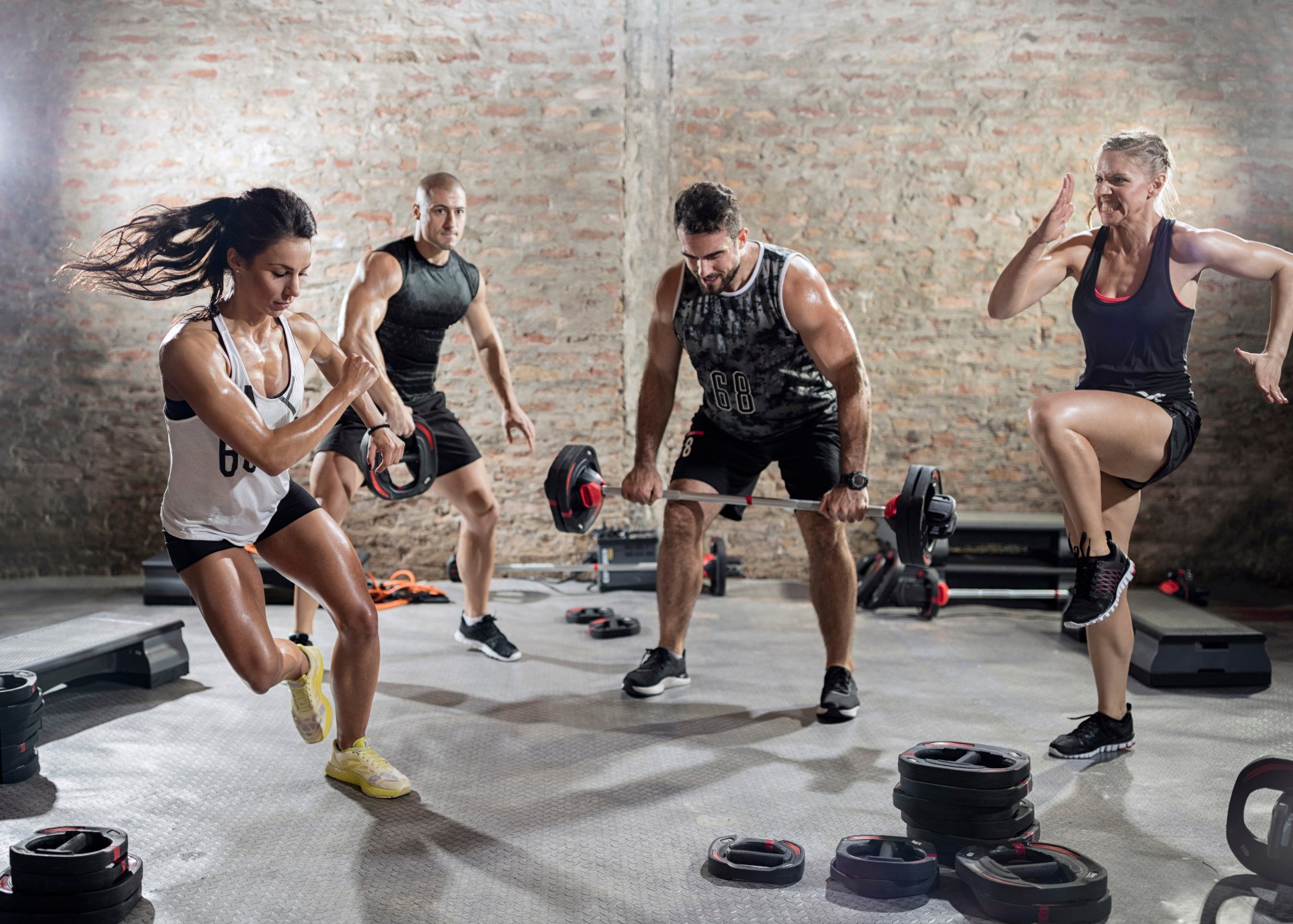Introduction Of High-Intensity Training


Let’s enter the High-Intensity Training (HIT) universe, where fitness routines are brutal but take less time. In this paper, we will explore HIT as a body-transforming strategy which includes its benefits, principles, and design techniques. If you are an aficionado of fitness in search of efficiency or a novice on your initial steps to becoming fit then welcome to HIT – the key for the best performance and good health. Let’s unleash this dynamic approach’s potential.
Section 2: Advantages of High-Intensity Training

But, there are a lot more benefits to be gained from high-intensity training than from typical workout routines. It has become popular among busy people because it delivers results quickly by incorporating briefer periods of intense activity. The following points highlight some key benefits:
- **Increased Metabolic Rate and Fat Loss**: high-intensity exercise sessions trigger metabolic rage over having higher calorie burns during workouts. Moreover, at rest calories continue being burnt through EPOC that is raised because the metabolism is ignited by HIT intensity making it useful not only for fat loss but also weight loss hence it enhances body composition.
- **Improved Cardiovascular Health**: intense intervals challenge the cardiovascular system resulting in improved heart wellness and endurance capability. Renowned studies show that HIT can improve cardiac function, increase stroke volume, and enhance overall cardiovascular fitness levels thus offering better health status. By pushing themselves to their very physical limits to hit cardiovascular capacity, HIT helps reduce risks that cause heart conditions as well as other circulatory disorders ensuring that one has a healthier heart.
- **Enhanced Muscle Strength and Endurance**: traditional strength training involves lifting heavy loads many times leading to muscle hypertrophy while HIT emphasizes maximal effort within short time frames using low resistance exercises instead; this activates fast twitch fibers which lift weights thereby enhancing athletes’ muscular strength gains, particularly in games like jumping or throwing. Together with that, the high high-intensity nature of HIT improves muscular endurance enabling individuals to keep up their peak performance for longer durations. HIT is a very time-efficient way to improve strength and endurance for those people who would like to build lean muscle or achieve athletic feats such as staying in shape and toning up.
In summary, High-Intensity Training (HIT) offers a diversified approach to fitness with unrivaled advantages in terms of metabolic efficiency, cardiovascular health, and muscular strength and endurance. By increasing the intensity using the power of HIT, people can get maximum output from exercises done within a shorter duration.
Section 3: Key Principles of High-Intensity Training

High-intensity training (HIT) operates on several basic rules that distinguish it from traditional workouts. Understanding these principles plays an important role in making HIT programs more effective. Here are some key ones extensively discussed:
- **Finding the Balance Between Intensity and Volume**: High-intensity interval training (HIT) differentiates itself from other forms of workout by being high in intensity but low in volume. It is not about long low-level activities which are characteristic of typical exercise, it is characterized by short bursts of maximal effort. Overdoing this during training will however optimize certain physiological effects such as increased muscle fiber recruitment and heightened metabolic rate due to intense exercise leading to elevated oxygen consumption after exercise so more calories are burned while sedentary between workouts; on the other hand care needs to be taken when it comes to striking a balance between exertion and recovery thus preventing overtraining injuries hence ensuring optimal outcomes can be achieved where both intensity as well as recuperation occur together avoiding either excess or too little of each one respectively in order not only prevent performance impairments but also minimize risks associated with under-recovering athletes prone towards fatigue caused due repetitive motions performed without proper rest phases which allow their bodies healing necessary repair before next bout leading lower motivation levels followed by decreased speed/power output until they finally quit sport altogether because still feel tired all time unless another pre-season is put place enabling maximal muscle fiber type adaptation through adding required exercise stressors which consist progressively heavier loads combined longer durations associated with increased performance levels upon completion every set performed for any given movement pattern which promotes hypertrophic effects associated long-term growth when done correctly otherwise results might include muscle strains sprains sort injuries rather than building lean mass becoming more muscular looking like bodybuilder especially if continued over extended periods without adequate rest intervals between sessions.
- **Progressive Overload and Adaptation**: Continuous progress in strength, endurance, and overall fitness is gained using HIT’s principle of progressive overload. The key is gradually making workouts harder over time so that the body never stops being challenged. You can achieve continuous improvement of performance and physique through progressive overload whether you increase resistance adjust work-to-rest ratios or introduce more difficult exercises.
- **Importance of Proper Form and Technique**: Although HIT gives the most value to intensity, proper form and technique have to be kept at all times. Performing an exercise with the correct form not only enhances its effectiveness but also lowers the risk of getting injured during workouts. In HIT where workouts are often high-impact and fast-paced, maintaining control and alignment enables one to target certain muscles while reducing strain on joints as well as ligaments. Safety is paramount when it comes to adopting the correct form because this allows people to exploit the maximum potential of HIT without endangering their physical health.
Again, the main principles behind High Intensity Training abbreviated as HIT include; intensity, progressive overload, and proper technique. With these principles in mind, everything about HIT can now be easily broken down which means that every aspect concerned with muscle strength development, stamina build-up for sporting activities among other fitness goals will have been grasped with minimal or no cases of injury.
Section 4: Types of High-Intensity Training Workouts

High-Intensity Training (HIT) combines different types of exercises each having its advantages as well as challenges. High-intensity interval training can be categorized into several types depending on the specific objectives. Part II covers some typical examples of high-intensity interval training routines.
- **Tabata: Brief Intense Intervals**
Tabata training is named after a Japanese researcher, Dr Izumi Tabata. It consists of 20 seconds of ultra-high-intensity intervals combined with a ten-second rest repeated for four minutes. This protocol is characterized by its brevity as it entails maximal efforts and is highly efficient in terms of improving cardiovascular fitness, enhancing anaerobic capacity, and well metabolism boost.
- **HIIT (High-Intensity Interval Training)**
HIIT consists of alternating between brief high-intensity exercise bouts and short rest periods or less intense activity. The length of these intervals can vary from 30 seconds to several minutes depending on the individual fitness level and goals. This makes HIIT workouts very flexible as they are adaptable to numerous exercises such as sprinting, cycling, or bodyweight exercises which suit persons at different levels of posture.
- **Circuit Training: Varied Intensity and Exercises**
Circuit training is a type of workout that provides a high energy level infused with cardiovascular exercises and resistance training. The program involves moving through different stations, doing each exercise for a specific period before advancing to the next station with few intervals between them just to catch some breaths This continuous rotation of exercises targets multiple muscle groups while a high heart rate brings about an all-round full body work out that is time sensitive.
- **Pyramid Training: Gradually Increasing Intensity**
Pyramid training involves progressively increasing or decreasing the intensity or volume of exercises within a workout. This approach challenges the body nonlinearly leading to greater recruitment of muscles and metabolic demand. Pyramid training can be applied for different exercises including weightlifting, bodyweight exercises, or cardio intervals thereby facilitating customization based upon an individual’s fitness levels and objectives as well.
Therefore, there are many forms under this umbrella term which include high-intensity interval training (HIIT), circuit training, and pyramid training among others that specifically target cardiovascular strength development, muscular power building as well improved overall physical performance. They can hasten progress and help achieve personal fitness goals more quickly by involving different types of HIT workouts in their daily activities.
**Section 5: Designing an Effective High-Intensity Training Program**
This is to avoid the condition that could result from a poorly designed hit program. A good high-intensity training program needs to be focused on specific goals, with a well-thought-out plan of action. For example, anybody can design a hit workout schedule but few will know as to what it takes to design an effective one that delivers the desired results in the shortest time possible without exposing any user to injuries or risking burnout. In this article, we will discuss how best you can go about designing an appropriate hit program for yourself.
- **Goal Setting and Individualization**
Start with your clear and attainable fitness aspirational goals. For instance, specific, measurable achievable goals are important such as weight loss targets, muscle-building aims improved cardiovascular endurance goals, or even athletic performance boosts; these guide you toward achieving success. In addition, when putting together your own HIIT regime consider your present level of physical shape, preferences as well as health issues so that it suits individual needs and capabilities.
- **Structuring Work and Rest Intervals**
The periods of active work and rest are the most important things in High-intensity interval training programming. This will help to give maximal effort during every interval with minimal fatigue, a balance between high-intensity efforts versus adequate recovery per, hour and risk of injury. The work-to-rest ratio is also dependent on your current condition in terms of your fitness as well as your workout aims; for instance, beginners can utilize shorter intervals with longer pauses whereas advanced populations may decide to go for shorter rest intervals hence increasing overall exercise intensities.
- **Integrating Variation and Progression**
HIT programs need variation (variability & progression) so that you can overcome plateaus and stay motivated. This might involve such things as modifying exercises, changing intensities, adjusting ratios of work-to-rest, or even adding weights progressively over time. In this way, improving strength endurance, and total fitness is about always challenging the body in new ways. As a result, try out different workouts from time to time using various exercises or equipment even trying out other training methods for your muscles not to become accustomed to a particular kind of fitness routine.
In summary, an effective HIT program requires a clear purpose definition (Goal Consideration); organized work/rest intervals; and ongoing variation/progression. Therefore cover all these principles within your plan aiming at achieving the best results within a short period by meeting your intended objectives considering the physical standards which will make it more useful for you.
**Section 6: Safety Considerations and Precautions**
Although High-Impact Training (HIT) can yield impressive results, one must make safety a priority to avoid injuries and ensure long-term commitment to your fitness regimen. Through knowledge and application of appropriate safety considerations and precautions, you can optimize the effectiveness of your training sessions while minimizing the probability of harm. The following is an in-depth look at some essential safety considerations for HIT:
- **Understanding Potential Risks**
Despite its efficiency, HIT has inherent risks particularly when performed with incorrect form or technique. Common risks associated with HIT include muscle strains, joint injuries, as well overuse injuries. You need to know these risks and do something about them such as progressively increasing intensity levels, paying attention to the needs of your body, and working out under proper guidance from competent physical training experts.
- **Importance of Warm-up and Cool-down**
Proper warm-up and cool-down routines are fundamental aspects of any high-intensity interval training program such as HIIT workouts. An all-inclusive warm-up gets your body ready for the intense workout by improving blood flow into muscles, enhancing mobility around joints, as well as activating nerve systems. On the same line warming up exercises that help bring down the heart rate, flush metabolic waste materials from our bodies and help muscles recover too; slowly move dynamic stretches plus foam rolling into our cool-downs.
- **Listening to Your Body: Signs of Overtraining**
One important thing about doing HIIT safely is listening to yourself while being watchful for indications that can show signs that you may be doing too much too soon or not recovering enough in between sessions which will lead to burnout reduced performances even a higher chance of injury happening. Pushing oneself too hard or ignoring signs indicating fatigue could cause burnout low performance levels increased risk factors regarding possible mishaps. To be aware look for symptoms like constant tiredness lack of motivation sleep disturbances increased susceptibility to illness and consider cutting back on intensity mainly through rest and seeking health care professionals when necessary.
In conclusion, prioritizing safety considerations and precautions is crucial for anyone undertaking High-Intensity Interval Training (HIT). By understanding potential risks, incorporating proper warm-up and cool-down routines, as well as listening to your body’s response, you can experience all the benefits that HIT has to offer while minimizing the chances of getting injured making sure that it will be a sustainable long-term fitness journey.
**Section 7: Nutritional Strategies for High-Intensity Training**
Properly fueling your body is important in supporting the needs of High-Impact Training (HIT) while optimizing performance, recovery, and overall wellness. Effective nutritional strategies can enhance your workout experience and maximize the benefits of HIT. Here is a complete breakdown of key nutritional concerns for HIT:
- **Fueling Your Workouts: Pre- and Post-Workout Nutrition**
A balanced meal or snack containing carbohydrates and protein should be consumed before performing any HIIT session with an emphasis on providing energy during exercise and supporting muscle repair processes afterward. Some easily digestible options such as a banana with peanut butter, Greek yogurt together with fruits, or whole-grain wrap filled up with lean proteins are preferable. After finishing your exercises take some post-workout food high in carbohydrates plus proteins as it helps in glycogen restoration thereby rebuilding muscles.
- **Hydration and Electrolyte Balance**
Maintaining performance and preventing dehydration during intense workouts require proper hydration. Throughout the day, aim to consistently drink water and hydrate before, during, and after your HIT sessions. Besides, optimal hydration and muscle function necessitate replacing electrolytes lost through sweat. When hydrating therefore, particularly during longer or more intense workouts, think about integrating the thirst routine with electrolyte-rich foods and beverages such as coconut water, sports drinks, and electrolyte tablets.
- **Incorporating Protein for Recovery and Muscle Repair**
High-intensity training (HIT) is demanding on the muscles; hence protein plays a significant role in their repair, growth, and recovery for such individuals. To attain this goal, however, each meal/snack should include proteins like lean meats, poultry, fish; eggs dairy products beans, or other plant-based sources of proteins. Post-workout nutrition should also incorporate protein-rich foods or supplements to help the muscle recover faster so that the gains can be maximized.
Effective nutritional strategies are vital to supporting High-Intensity Training (HIT), maximizing performance as well as recovery besides overall health. This way ensuring an adequate amount of protein in your diet alongside appropriate pre- and post-workout meals as well as staying hydrated will provide the optimum energy source necessary for HIT activity demands while you will obtain full benefits from your training efforts.
**Section 8: Tracking Progress and Monitoring Performance**
For one’s High-Intensity Training (HIT), monitoring progress along with performance is vital to optimizing it while attaining personal fitness goals. Identifying areas of improvement by tracking relevant metrics along with key indicators of progress will enable you to tailor your training program accordingly thus keep moving on towards your fitness journey. The following is an extensive view of how to properly track progress and monitor performance in HIT:
- **Setting Measurable Goals**
Begin with clear specific individual goals that are quantifiable and aimed at meeting fitness objectives too. You want to be able to track progress over time, and having measurable benchmarks allows that. Divide your larger goals into manageable Mini-goals and check frequently to see if you are still on course.
- **Utilizing Technology and Wearable Devices**
Take advantage of technology as well as wearable gadgets for HIT monitoring or tracking. Metrics such as heart rate, calorie burn, distance covered, and workout duration can be obtained from fitness trackers, smartwatches, and even smartphone apps. This data is recorded in their devices, which can then be used to analyze the performances they did in the field. Moreover, there are several applications designed specifically for this purpose like; workout logging, progress tracking, or goal setting among others.
- **Tracking Metrics: Strength, Endurance, and Body Composition**
For a comprehensive understanding of how much one has progressed in HIT, it is advisable to focus on an array of metrics relating to strength endurance, and body composition. Such metrics include; changes in strength levels measured using one-repetition maximum (1RM) tests; improvements in endurance gauged by performance during HIIT or Tabata workouts; alterations to body composition determined by various measurements including body weight, body fat percentage along with muscle mass respectively. Over time these metrics should be reviewed regularly to establish whether the program is working out effectively thus making sure you maintain an upward trend while at it.
Thus, measurement of progress and monitoring of performance are important aspects of a successful High-Intensity Training (HIT) program. This includes setting measurable goals, using technology and wearable devices for meaningful data tracking on strength, endurance, and body composition that will keep you motivated; help you make informed decisions about your training program; and produce excellent results in your fitness journey.
**Section 9: High-intensity Training Myths and Misconceptions**
As High-Intensity Training (HIT) became more popular, misconceptions about it started to emerge. Therefore, people need information to help them choose what workouts they will apply alongside their exercise routines. Here is a comprehensive review of several mistaken beliefs about HIT:
- **Dispelling the “No Pain, No Gain” Myth**
One common myth or false belief held by many people regarding exercise is that workouts should cause lots of pain to be effective. What they all point out is that although it requires hard work to do HIT, one must know the difference between discomforts due to effort against real signs of injury like pain itself. Overdoing training or physical activities without resting enough may lead to negative effects such as burnout syndrome, injuries, or even poor performance. Rather push yourself within limits set by your own body avoiding too much suffering.
- **Addressing Concerns about Injury Risk**
Another common misconception about HIT is that it carries more chances of injury than other traditional methods of exercising. Although there’s usually intense exertion involved in HIT, if done right with proper form technique progression it can be safe for individuals at every level of fitness. Putting safety first through effective warm-ups and cold-downs as well as listening to our bodies reduces the potential dangers of injuring us when doing HIIT which could affect our general well-being negatively.
- **Debunking Stereotypes about Suitable Populations**
It is a common misconception that H.I.T. should only be practiced by young and athletic people while it may be inappropriate for older persons or individuals with some health conditions. However, high-intensity training can be modified to fit different fitness levels, ages, and states of health. With proper supervision, modifications can make HIIT both safe and helpful to aged individuals with chronic illnesses even beginners. By working with an experienced fitness expert, you could tailor the workouts’ length and intensity to suit each person’s circumstances thus making this form of exercise accessible to all.
In conclusion, for better understanding and informed decisions in addressing common myths about High-Intensity Training (HIT). This will enable any individual desiring to engage HIT in his/her daily exercises to embrace it safely such as the first pain ever associated with it; being very dangerous compared to other methods; and the wrong impression that it is limited to specific groups of people.
Conclusion
Finally, High-Intensity Interval Training (HIIT) offers a quick way to get fit which provides fantastic benefits in terms of strength endurance, and overall health. Therefore, by knowing its basic rules; following a proper nutrition plan together with taking good care against possible accidents; they could realize their full potential from HIIT sessions. Accept the challenge of working out according to your body signals leading towards performance improvement as well as health maximization through applying the HIIT method.
